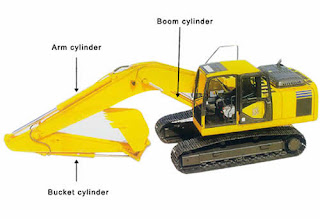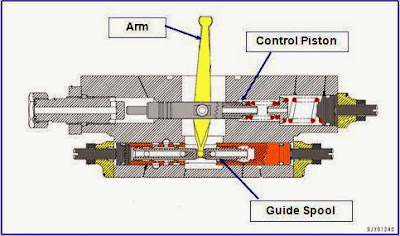The advantage of using a hydraulic machine is that more force and
torque can be generated with relatively smaller sized machines without
requiring a gear system. An important component of a hydraulic machine
is the hydraulic pump. The supply of fluids like oil and water to the
various components of the machine is accomplished by using hydraulic
pumps. Their mechanism is based on the displacement of the fluid volume
against a resistant load or pressure.
Hydraulic Machinery
The machines that make use of fluid power to carry out the necessary function or to do work in general are called hydraulic machinery. In these machines, a fluid having high velocity is distributed to the hydraulic motors and hydraulic cylinders through tubes of small diameters. This fluid is known as the hydraulic fluid, and it can be oil, water, gas, etc. Control on the fluid is exercised with the help of control valves that are controlled automatically. A hydraulic pump is an important component of the working process of a hydraulic motor.
Basic Concept of Hydraulic Pumps
Basically, pumps are meant to impart energy to anything flowing through them. They transfer the fluid from a low potential to a high potential as in heat pumps. When a fluid enters a hydraulic pump, it has some velocity of its own. Now, with the help of an external energy source the pump boosts the velocity of the fluid. The rotating parts inside the pump carry out processes like confining the fluid in a certain volume and displacing it to increase its energy. It should be noted that hydraulic pumps do not generate any pressure, and they simply render the fluid with more velocity.
Positive Displacement Pump Principle
In general, pumps can be classified as positive displacement pumps and non-positive displacement pumps. Hydraulic systems mostly make use of positive displacement pumps. As the article is on the processing of hydraulic pumps, working of the positive displacement pumps will be discussed further. Positive displacement implies displacing a fixed quantity of something. In the case of hydraulic pumps fluids, a positive displacement pump has an increasing opening on the suction side of the pump and a decreasing outlet on the discharge side. When liquid flows in to the pump, it is forced out with greater velocity as the discharge side outlet is decreasing in size. Positive displacement pumps can further be classified under subcategories according to the motion pattern of the enclosed volume forming parts. Operating a positive displacement pump against a closed valve on the discharge side should be avoided, and a safety valve on the discharge side of this pump is mandatory.
Types of Positive Displacement Pumps
Reciprocating Pumps
This is the most basic type of positive displacement pump. In a reciprocating positive displacement pump, the moving part that is the piston, has a reciprocating motion. The discharge in this pump is pulsating and varies only when the speed of the pump is changed. The reason being that the intake is in constant volumes. Reciprocating pumps are often implemented for sludge and slurry. The two types of reciprocating pumps are plunger pumps and diaphragm pumps.
Metering Pumps
These pumps are used for precisely controlling very low flow rates. Flow rates are generally less than ½ gallon per minute. They are usually used to control additives to the main flow stream. These pumps are also called controlled volume pumps. Metering pumps have types such as diaphragm and packed plunger. Unlike the reciprocating positive displacement pumps, the metering pumps are meant to be used for clean fluids and impurities that can clog the valves of the pump.
Rotary Pumps
The rotary positive displacement hydraulic pumps come in the following types - the gear pumps, lobe pumps, vane pumps, progressive cavity pumps, peripheral pumps, and screw pumps. In these pumps, rotary motion carries the liquid from the pump inlet to the pump outlet. The fluid gets trapped in the closed casing of the rotary pump and is discharged in a smooth flow.
The basic information on the mechanism of hydraulic pumps, and their various types, has been provided above to give you an introduction to the subject. Hydraulics in itself, is a vast field and various books are available that will provide you more in depth information on the it.
Hydraulic Machinery
The machines that make use of fluid power to carry out the necessary function or to do work in general are called hydraulic machinery. In these machines, a fluid having high velocity is distributed to the hydraulic motors and hydraulic cylinders through tubes of small diameters. This fluid is known as the hydraulic fluid, and it can be oil, water, gas, etc. Control on the fluid is exercised with the help of control valves that are controlled automatically. A hydraulic pump is an important component of the working process of a hydraulic motor.
Basic Concept of Hydraulic Pumps
Basically, pumps are meant to impart energy to anything flowing through them. They transfer the fluid from a low potential to a high potential as in heat pumps. When a fluid enters a hydraulic pump, it has some velocity of its own. Now, with the help of an external energy source the pump boosts the velocity of the fluid. The rotating parts inside the pump carry out processes like confining the fluid in a certain volume and displacing it to increase its energy. It should be noted that hydraulic pumps do not generate any pressure, and they simply render the fluid with more velocity.
Positive Displacement Pump Principle
In general, pumps can be classified as positive displacement pumps and non-positive displacement pumps. Hydraulic systems mostly make use of positive displacement pumps. As the article is on the processing of hydraulic pumps, working of the positive displacement pumps will be discussed further. Positive displacement implies displacing a fixed quantity of something. In the case of hydraulic pumps fluids, a positive displacement pump has an increasing opening on the suction side of the pump and a decreasing outlet on the discharge side. When liquid flows in to the pump, it is forced out with greater velocity as the discharge side outlet is decreasing in size. Positive displacement pumps can further be classified under subcategories according to the motion pattern of the enclosed volume forming parts. Operating a positive displacement pump against a closed valve on the discharge side should be avoided, and a safety valve on the discharge side of this pump is mandatory.
Types of Positive Displacement Pumps
Reciprocating Pumps
This is the most basic type of positive displacement pump. In a reciprocating positive displacement pump, the moving part that is the piston, has a reciprocating motion. The discharge in this pump is pulsating and varies only when the speed of the pump is changed. The reason being that the intake is in constant volumes. Reciprocating pumps are often implemented for sludge and slurry. The two types of reciprocating pumps are plunger pumps and diaphragm pumps.
Metering Pumps
These pumps are used for precisely controlling very low flow rates. Flow rates are generally less than ½ gallon per minute. They are usually used to control additives to the main flow stream. These pumps are also called controlled volume pumps. Metering pumps have types such as diaphragm and packed plunger. Unlike the reciprocating positive displacement pumps, the metering pumps are meant to be used for clean fluids and impurities that can clog the valves of the pump.
Rotary Pumps
The rotary positive displacement hydraulic pumps come in the following types - the gear pumps, lobe pumps, vane pumps, progressive cavity pumps, peripheral pumps, and screw pumps. In these pumps, rotary motion carries the liquid from the pump inlet to the pump outlet. The fluid gets trapped in the closed casing of the rotary pump and is discharged in a smooth flow.
The basic information on the mechanism of hydraulic pumps, and their various types, has been provided above to give you an introduction to the subject. Hydraulics in itself, is a vast field and various books are available that will provide you more in depth information on the it.





 Posted by Unknown
Posted by Unknown
 Saturday, December 28, 2013
Saturday, December 28, 2013



















